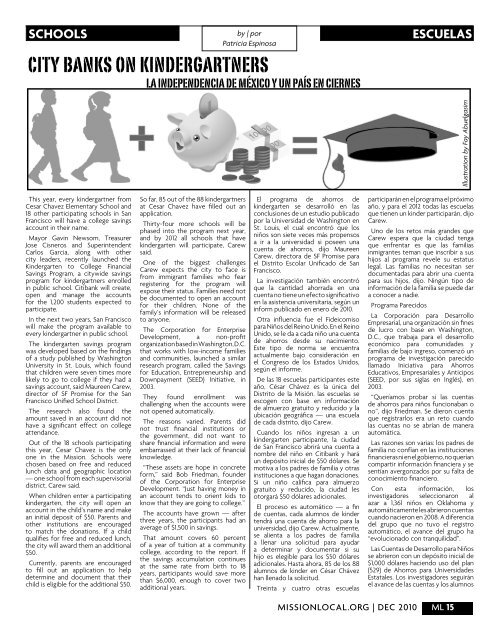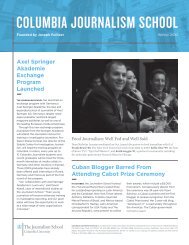miSSiOn StreetS/ FOtOS del barriO - Media Server
miSSiOn StreetS/ FOtOS del barriO - Media Server
miSSiOn StreetS/ FOtOS del barriO - Media Server
Create successful ePaper yourself
Turn your PDF publications into a flip-book with our unique Google optimized e-Paper software.
Schoolsby | porPatricia EspinosaCity Banks on KindergartnersLa Independencia de México y un País en CiernesEscuelasIllustration by Fay AbuelgasimThis year, every kindergartner fromCesar Chavez Elementary School and18 other participating schools in SanFrancisco will have a college savingsaccount in their name.Mayor Gavin Newsom, TreasurerJose Cisneros and SuperintendentCarlos Garcia, along with othercity leaders, recently launched theKindergarten to College FinancialSavings Program, a citywide savingsprogram for kindergartners enrolledin public school. Citibank will create,open and manage the accountsfor the 1,200 students expected toparticipate.In the next two years, San Franciscowill make the program available toevery kindergartner in public school.The kindergarten savings programwas developed based on the findingsof a study published by WashingtonUniversity in St. Louis, which foundthat children were seven times morelikely to go to college if they had asavings account, said Maureen Carew,director of SF Promise for the SanFrancisco Unified School District.The research also found theamount saved in an account did nothave a significant effect on collegeattendance.Out of the 18 schools participatingthis year, Cesar Chavez is the onlyone in the Mission. Schools werechosen based on free and reducedlunch data and geographic location— one school from each supervisorialdistrict, Carew said.When children enter a participatingkindergarten, the city will open anaccount in the child’s name and makean initial deposit of $50. Parents andother institutions are encouragedto match the donations. If a childqualifies for free and reduced lunch,the city will award them an additional$50.Currently, parents are encouragedto fill out an application to helpdetermine and document that theirchild is eligible for the additional $50.So far, 85 out of the 88 kindergartnersat Cesar Chavez have filled out anapplication.Thirty-four more schools will bephased into the program next year,and by 2012 all schools that havekindergarten will participate, Carewsaid.One of the biggest challengesCarew expects the city to face isfrom immigrant families who fearregistering for the program willexpose their status. Families need notbe documented to open an accountfor their children. None of thefamily’s information will be releasedto anyone.The Corporation for EnterpriseDevelopment, a non-profitorganization based in Washington, D.C.that works with low-income familiesand communities, launched a similarresearch program, called the Savingsfor Education, Entrepreneurship andDownpayment (SEED) Initiative, in2003.They found enrollment waschallenging when the accounts werenot opened automatically.The reasons varied. Parents didnot trust financial institutions orthe government, did not want toshare financial information and wereembarrassed at their lack of financialknowledge.“These assets are hope in concreteform,” said Bob Friedman, founderof the Corporation for EnterpriseDevelopment. “Just having money inan account tends to orient kids toknow that they are going to college.”The accounts have grown — afterthree years, the participants had anaverage of $1,500 in savings.That amount covers 60 percentof a year of tuition at a communitycollege, according to the report. Ifthe savings accumulation continuesat the same rate from birth to 18years, participants would save morethan $6,000, enough to cover twoadditional years.El programa de ahorros dekindergarten se desarrolló en lasconclusiones de un estudio publicadopor la Universidad de Washington enSt. Louis, el cual encontró que losniños son siete veces más propensosa ir a la universidad si poseen unacuenta de ahorros, dijo MaureenCarew, directora de SF Promise parael Distrito Escolar Unificado de SanFrancisco.La investigación también encontróque la cantidad ahorrada en unacuenta no tiene un efecto significativoen la asistencia universitaria, según uninform publicado en enero de 2010.Otra influencia fue el Fideicomisopara Niños <strong>del</strong> Reino Unido. En el ReinoUnido, se le da a cada niño una cuentade ahorros desde su nacimiento.Este tipo de norma se encuentraactualmente bajo consideración enel Congreso de los Estados Unidos,según el informe.De las 18 escuelas participantes esteaño, César Chávez es la única <strong>del</strong>Distrito de la Misión. las escuelas seescogen con base en informaciónde almuerzo gratuito y reducido y laubicación geográfica — una escuelade cada distrito, dijo Carew.Cuando los niños ingresan a unkindergarten participante, la ciudadde San Francisco abrirá una cuenta anombre <strong>del</strong> niño en Citibank y haráun depósito inicial de $50 dólares. Semotiva a los padres de familia y otrasinstituciones a que hagan donaciones.Si un niño califica para almuerzogratuito y reducido, la ciudad lesotorgará $50 dólares adicionales.El proceso es automático — a finde cuentas, cada alumnos de kindertendrá una cuenta de ahorro para launiversidad, dijo Carew. Actualmente,se alienta a los padres de familiaa llenar una solicitud para ayudara determinar y documentar si suhijo es elegible para los $50 dólaresadicionales. Hasta ahora, 85 de los 88alumnos de kinder en César Chávezhan llenado la solicitud.Treinta y cuatro otras escuelasparticiparán en el programa el próximoaño, y para el 2012 todas las escuelasque tienen un kinder participarán, dijoCarew.Uno de los retos más grandes queCarew espera que la ciudad tengaque enfrentar es que las familiasinmigrantes teman que inscribir a sushijos al programa revele su estatuslegal. Las familias no necesitan serdocumentadas para abrir una cuentapara sus hijos, dijo. Ningún tipo deinformación de la familia se puede dara conocer a nadie.Programa ParecidosLa Corporación para DesarrolloEmpresarial, una organización sin finesde lucro con base en Washington,D.C., que trabaja para el desarrolloeconómico para comunidades yfamilias de bajo ingreso, comenzó unprograma de investigación parecidollamado Iniciativa para AhorrosEducativos, Empresariales y Anticipos(SEED, por sus siglas en Inglés), en2003.“Queríamos probar si las cuentasde ahorros para niños funcionaban ono”, dijo Friedman. Se dieron cuentaque registrarlos era un reto cuandolas cuentas no se abrían de maneraautomática.Las razones son varias: los padres defamilia no confían en las institucionesfinancieras ni en el gobierno, no queríancompartir información financiera y sesentían avergonzados por su falta deconocimiento financiero.Con esta información, losinvestigadores seleccionaron alazar a 1,361 niños en Oklahoma yautomáticamente les abrieron cuentascuando nacieron en 2008. A diferencia<strong>del</strong> grupo que no tuvo el registroautomático, el avance <strong>del</strong> grupo ha“evolucionado con tranquilidad”.Las Cuentas de Desarrollo para Niñosse abrieron con un depósito inicial de$1,000 dólares haciendo uso <strong>del</strong> plan(529) de Ahorros para UniversidadesEstatales. Los investigadores seguiránel avance de las cuentas y los alumnosmissionlocal.org | DEC 2010 ML 15



